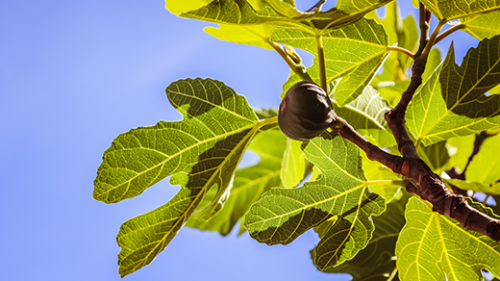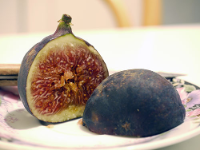Growing Figs in Kansas

Last week, I had an interesting question from an individual who had been given some red figs and wanted to save the seeds to grow fig trees. Growing fig trees from seed outdoors in Kansas is likely to fail, especially if you get the figs from the grocery store, but you can grow fig trees successfully in Kansas.
Fig trees (Ficus carica) are native to the Mediterranean basin and are members of the Mulberry family. You may be familiar with other Mulberry family members, including the ornamental rubber tree and the Osage Orange. In their native climate, fig trees are evergreen plants, but in Kansas, where the temperatures get below 25-27 degrees F, the plants will lose their leaves in the winter. While figs might be known as the fruit without a flower, they do flower. The flower is hidden within the fruit and is not visible. In warmer climates, fig trees will bear two crops of fruit a year; the first is on the previous year's shoot growth, and the second is in the leaf axils of the current year's growth. We usually only get one crop of figs in Kansas unless we have a warmer winter. There are four types of figs: Caprifigs, Smyrna, San Pedro, and Common. The first three types of figs are not recommended in Kansas because they have issues with pollination, setting fruit, and fruit drop. Over 600 varieties of Common-type figs are available, but only a few are hardy for our location. Most fig varieties are self-fruitful, but some require cross-pollination to bear, so keep this in mind when choosing varieties. 'Chicago Hardy', 'Stella', 'Olympic', and 'Peter's Honey Fig' are all recommended by The Giving Grove of Kansas City. 'Florea' is a variety recommended for cold climates by One Green World (of Portland, Ore.).
Figs grow well on a wide range of soil types if the soil is well-drained and reasonably fertile. They need to be watered consistently for the first few years after being planted and during periods of drought. Once established, figs are native to dry soil conditions and tolerate drought well. Figs should be planted in full sun, but protect them from the harsh summer and winter winds. The issue with growing figs in Kansas is the winter temperatures. The varieties recommended are hardy to approximately 0 degrees but can die off in winters with colder temperatures. In cold winters, with temperatures below 15 degrees, figs will freeze off to the ground level and come back as a small shrub the following year. Trees should be insulated if possible to prevent winter kill. There are many ways to protect these trees from severe cold. Pick a location close to a house or a backyard wall to plant figs to insulate them from drying winds and cold temperatures. Wrapping the trees in burlap or tar paper can also provide protection. Another method is to build a cage around the tree with chicken wire and then fill the space in the cage with either hay or composted mulch. Figs can be grown in containers outdoors during the summer, provided you move them inside in the winter to an area where the plant can go dormant during the cold months.
fertile. They need to be watered consistently for the first few years after being planted and during periods of drought. Once established, figs are native to dry soil conditions and tolerate drought well. Figs should be planted in full sun, but protect them from the harsh summer and winter winds. The issue with growing figs in Kansas is the winter temperatures. The varieties recommended are hardy to approximately 0 degrees but can die off in winters with colder temperatures. In cold winters, with temperatures below 15 degrees, figs will freeze off to the ground level and come back as a small shrub the following year. Trees should be insulated if possible to prevent winter kill. There are many ways to protect these trees from severe cold. Pick a location close to a house or a backyard wall to plant figs to insulate them from drying winds and cold temperatures. Wrapping the trees in burlap or tar paper can also provide protection. Another method is to build a cage around the tree with chicken wire and then fill the space in the cage with either hay or composted mulch. Figs can be grown in containers outdoors during the summer, provided you move them inside in the winter to an area where the plant can go dormant during the cold months.
Fig trees are a great addition to an orchard for homeowners who want to grow a different type of fruit in their landscape. Just be aware that birds and other wildlife love the fruit, so be prepared to cover the trees with netting to prevent wildlife from raiding your orchard. You can also plant figs specifically for the wildlife to enjoy. If you are considering planting figs, try to research the variety first, and don’t try to grow seeds from figs in a grocery store because they likely won’t be hardy in Kansas.

Have questions? Contact our office where our Horticulture Extension Agent will assist you with questions.
Phone: (316) 321-9660
Email: callae@ksu.edu